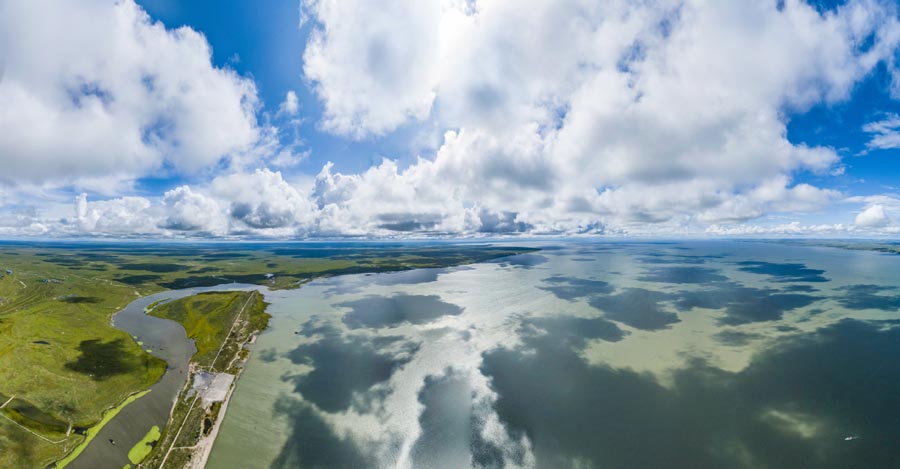
From the People's Daily App.
This is Story in the Story.
Hulunbuir Grassland is widely seen as China's most well-preserved grassland. With more than 120 kinds of pastures, it has the name as "the purest grassland."
It got its name thanks to ongoing preventive efforts against destruction.
Drought and overgrazing once ruined pastures there, but now things are getting better under collective management of grazing intensity, and rotational grazing.
In the past decade, as the fame of the Hulunbuir Grassland spread around the world, a rising number of tourists has put new pressure on grassland protection, bringing tourist money but also tire tracks and garbage.
Today’s Story in the Story looks at the steps taken by Hulunbuir authorities to preserve the area while also enabling farmers to thrive.

Green grass, blue sky and white clouds are reflected on the mirror-like surface of Hulun Lake, forming a picturesque aerial view in Hulunbuir, North China's Inner Mongolia autonomous region, Aug 28, 2019. (Photo: Xinhua)
Spanning over 253,000 square kilometers, Hulunbuir is a famous tourist destination in North China's Inner Mongolia autonomous region. It's known for beautiful grasslands and vast forests containing more than 500 lakes, 3,000 rivers and large areas of wetlands.
Home to more than 40 ethnic groups, including the Mongolian, Daur and Ewenki people, Hulunbuir also sees diversified folk culture.
46-year-old herdsman Badema knows all too well how drought and overgrazing once ruined pastures and her earnings. Now she works on a cooperative farm with 30 other households.
Alatanbagen, chairman of the husbandry company that runs the cooperative farm, said cooperative production mode enhances the people's awareness of environmental protection and sustainable grazing. "It prevents the destruction of meadows while improving the quality of mutton. So, herdsmen's incomes grow while the amount of stocks is restrained," he added.
Herding is not the only industry that is closely bound to this fertile land. Late in the 20th century, Hulunbuir Grassland saw a boom in open-pit mining. Thousands of small coal mines left countless scars on the surface of the grasslands, as Inner Mongolia gradually grew into China's biggest coal producer. It became the darkest time for the region's greenery.
Baorixile town, which was established for mining development, once suffered from that. "But low-productivity small coal mines were shut down by 2004. Most of them have switched to other businesses," said locals.
Apart from that, Hulunbuir authorities have committed to pasture upgrading, desertification prevention and the construction of a nature reservation. That has cleared away some of the bare land while making new development paths.
Old Barag Banner situated in the heartland of the great grassland has launched a series of campaigns to keep touring vehicles and illegal building away from their gorgeous landmark – the Morigele River. Public construction has also been set up to deal with increasing food waste and domestic sewage.

Morigele River (Photo: CGTN)
"Spatial planning draws a clear line between what to exploit and what to protect. Based on that, there should be detailed categorization for each industry, laying out how to develop in a way that matches with our local features," said Yang Aijun, the deputy mayor of Old Barag Banner.
He gave an example that the banner is now developing a grass industry cluster whereby stock farming and technological studies grow together, which raises both their profile and income.
It is a universally critical issue for the fast-growing country – how to achieve a balance between environment and growth. And Hulunbuir people choose to safeguard China's ecological barrier in the North and exploit the green gold mine.
A multibillion yuan reforestation project that started 20 years ago has helped raise forest coverage in environmentally fragile regions, diversify farmers' incomes and curb greenhouse gases, said Zhang Jianlong, head of the National Forestry and Grassland Administration.
He said the landmark program to return cropland to forest and grassland has cost the central government more than 500 billion yuan ($72.6 billion) over the years.
The amount is nearly triple the cost of the Three Gorges Dam, the world's largest hydroelectric project, and makes it the world's most expensive ecological project.
"Benefits of all kinds are steadily presenting themselves," he said.
Figures provided by the administration show 33.8 million hectares of farmland have been converted to forests and pastures since the project started in 1999, with 41 million farmers directly involved.
Forest coverage in regions included in the program has increased by an average of 4 percentage points in the past 20 years, the administration said.
(Produced by Nancy Yan Xu, Brian Lowe, Lance Crayon and Elaine Yue Lin. Music by: bensound.com. Text from CGTN and China Daily.)


